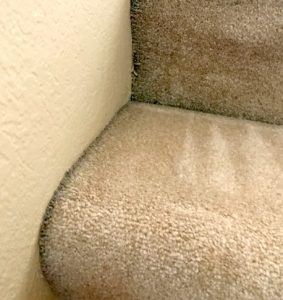A technician just told you some story about the dark edges “filtration lines” around your room and at your doorway and that you have to pay more. But isn’t it just dirt? What are filtration lines? Why on earth should you pay more for this?
 Filtration lines (soiling) are those dark lines or bands of soils that you find along walls, under doors that are kept closed for a length of time, under the skirting of furniture, and more. Found in many homes and some commercial settings — mainly in colder climates — filtration soiling is tough to remove and takes time to do so properly.
Filtration lines (soiling) are those dark lines or bands of soils that you find along walls, under doors that are kept closed for a length of time, under the skirting of furniture, and more. Found in many homes and some commercial settings — mainly in colder climates — filtration soiling is tough to remove and takes time to do so properly.
Nearly all of our fellow cleaners charge more for this service, as do we.
Why do you charge more?
Filtration line soil is oily and so small that cleaning them or removing them from fibers is difficult, in addition to an electric charge, that bonds them to the fiber.
What causes these dark lines?
Filtration lines are not picky and will appear in any type of home, business or facility.
They are caused by a combination of air quality and construction.
- A BASIC LESSON IN PHYSICS (hammered into me by my father many years ago)
- Warm air moves up, and as it cools, drops back down.
- But warm air also likes cool surfaces.
- This means that as air is warmed, typically while the furnace (heater) runs, and then – full of pollutants – goes up and then searches out cooler surfaces, such as an outside wall or another room.
As warm air moves toward a cooler area, it will push its way through carpeted surfaces (under doors, etc.) and “clean itself.” The carpet acts as a filter. Even more so when air moves from one room to another, or under furniture, etc.
What is left behind is a buildup of oily soils that are very difficult to remove. As more time passes, more soils build up and soon you have a tremendous cleaning challenge.
What do we do about them?
Without boring you with a bunch of shop lingo, the process can take a few steps and multiple tries.
• We apply a gel solvent to the filtration lines
• To protect the wall or baseboard, we use a “shim” of some kind.
• We work the solution with as much agitation as we can for the fiber type
• We apply a strong oxygenating product
• We agitate the chemicals on the fiber and let them mix and dwell for several minutes.
• We rinse and repeat until satisfied.
So now that you are educated on Filtration Lines, which you may have not even noticed before that you have – check your edges and give us a call!
Request a Quote
We’ll be in contact with you shortly to give you an estimate.
